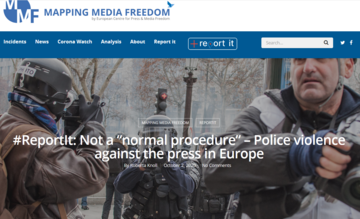
The screenshot of the page with the article
Related contents
Press Freedom Police CodexMAPPING MEDIA FREEDOM: a Four-Month Snapshot
113 journalists and media workers in EU Member States and Candidate States have suffered physical violence from police officers since 2014, according to MappingMediaFreedom.org .
German video reporter Julian Stähle is one of those who have been attacked for carrying out their work. When filming a special services operation in the Berlin region, Stähle was injured when an officer suddenly threw him to the ground. However, it was Stähle who found himself in court. The officer who denounced him claimed that the reporter had started the confrontation. Two of his colleagues testified in support of this fiction.
It took a year to prove that he was the victim of the German police , not the perpetrator. Stähle was finally able to show his video-footage of the incident in the court. The footage was so damning that it made one of the officers who had just testifying under oath faint. Stähle’s experience of the police’s use of arbitrary violence caused public outrage and it remains one of the most egregious cases of police violence in Germany, while also demonstrating the extent to which police officers can attempt to avoid justice. Unfortunately this was not an isolated case. During the May Day demonstrations in Berlin this year a police officer hit a female camera-assistant so brutally, that several of her teeth were knocked out.
While this type of case is quite rare in Germany, in France the level of police violence against reporters is far more severe. In the first six months of the “Yellow Vests” protests, which began in November 2018, Reporter without Borders counted 54 journalists injured by police officers. 42 of them were severely injured. Journalist David Dufresne, who set up a monitoring process due to the increased reports of police misconduct connected to the Yellow Vest protests has registered several hundred cases of unethical behaviour.
Every attack and every failure to respond undermines France’s commitment to media freedom and the underpinnings of democracy. If things are bad, the recently introduced National Policing plan will not improve matters. Designed as an approach for a “better consideration of the presence of journalists during law enforcement operations” as French minister of interior, Gérald Darmanin, called it, the current plan appears to miss its mark. It discriminates against journalists who are not holding officially accredited press cards, preventing them from wearing protective clothing such as helmets when covering demonstrations, while also enabling the police to exclude journalists from remaining in a crowd after police warnings.
The full article signed by Martin Hoffmann is published by Mapping Media Freedom.
Tags: France Germany Safety of journalists Media capture
This content is part of the Media Freedom Rapid Response (MFRR), a Europe-wide mechanism which tracks, monitors and responds to violations of press and media freedom in EU Member States and Candidate Countries. The project is co-funded by the European Commission.


